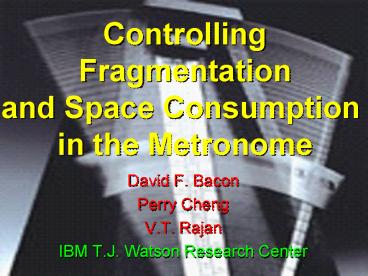David F' Bacon PowerPoint PPT Presentation
1 / 28
Title: David F' Bacon
1
Controlling Fragmentation and Space Consumption
in the Metronome
- David F. Bacon
- Perry Cheng
- V.T. Rajan
- IBM T.J. Watson Research Center
2
Problem Domain
- Hard real-time garbage collection
- Implemented for Java
- Uniprocessor
- Multiprocessors rare in real-time systems
- Complication collector must be finely
interleaved - Simplification memory model easier to program
- No truly concurrent operations
- Sequentially consistent
3
Metronome Project Goals
- Make GC feasible for hard real-time systems
- Provide simple application interface
- Develop technology that is efficient
- Throughput, Space comparable to stop-the-world
- BREAK THE MILLISECOND BARRIER
- While providing even CPU utilization
4
Outline
- Overview of the Metronome
- Empirical Results
- What is Fragmentation?
- Static and dynamic measures
- How do we control space consumption?
- Conclusions
5
The Metronome Collector
6
Real-time GC Approaches
- Mark-sweep (non-copying)
- Fragmentation avoidance, coalescing
- Subject to space explosion
- Semi-space Copying
- Concurrently copies between spaces
- Cost of copying, consistency, 2x space
- The Metronome
- Mark-sweep, selective defragmentation
- Best of both, adaptively adjusts
7
Components of the Metronome
- Incremental mark-sweep collector
- Mark phase fixes stale pointers
- Selective incremental defragmentation
- Moves lt 2 of traced objects
- Time-based scheduling
- Segregated free list allocator
- Geometric size progression limits internal
fragmentation
Old
New
8
Support Technologies
- Read barrier to-space invariant Brooks
- New techniques with only 4 overhead
- Write barrier snapshot-at-the-beginning Yuasa
- Arraylets bound fragmentation, large object ops
Old
New
9
Empirical Results
10
Pause time distribution javac
Time-based Scheduling
Work-based Scheduling
12 ms
12 ms
11
Utilization vs. Time javac
Time-based Scheduling
Work-based Scheduling
1.0
1.0
0.8
0.8
Utilization ()
0.6
0.6
0.45
0.4
0.4
0.2
0.2
0.0
0.0
Time (s)
Time (s)
12
Space Usage javac
13
Parameterization
Mutator a(?GC) m
Tuner ?t s u
Allocation Rate
Real Time Interval
Maximum Live Memory
Maximum Used Memory
Collector R
CPU Utilization
Collection Rate
14
Is it real-time? Yes
- Maximum pause time lt 4 ms currently
- MMU gt 50 2
- Memory requirement lt 2 X max live
15
Static Fragmentation
16
Segregated Free List Allocator
- Heap divided into fixed-size pages
- Each page divided into fixed-size blocks
- Objects allocated in smallest block that fits
12
16
24
17
Fragmentation on a Page
- Internal wasted space at end of object
- Page-internal wasted space at end of page
- External blocks needed for other size
page-internal
internal
external
18
Fragmentation ?1/8 vs. ?1/2
19
Dynamic Fragmentation
20
Locality of Size ?
- Measures reuse
- Normalized 0?1
- Segregated by size
Allocated
Freed
Bytes
Allocated
Freed
Freed
Allocated
Perfect Reuse
Freed Reused
Allocated Reused
? Si min ( fi / f, ai / a)
21
? in Real-time GC Context
- Mark-sweep (non-copying)
- Semi-space Copying
- The Metronome
Assumes ?1
Assumes ?0
Adapts as ? varies
22
? in Practice
23
Controlling Space Consumption
24
Triggering Collection
Defrag
PAGES
Free
MS 1
MS 2
MS 3
DF 1
DF 2
TIME
25
Factors in Space Consumption
?
MS 1
MS 2
MS 3
DF 1
DF 2
R
26
Reducing Space Consumption
- Collection Rate R
- Higher rate less memory reserve needed
- Speed up collector
- Specify rate more precisely (bound worst-case)
- Locality of Size ?
- Higher locality less free page reserve needed
- Specify page requirement more precisely
27
Conclusions
28
Conclusions
- Contributions
- Time-based scheduling (Tunable)
- Mostly non-copying collection (? varies)
- Efficient software read barrier
- Precise definition of fragmentation
- Precise specification of collection triggers
- The Metronome provides true real-time GC
- First collector to do so without major sacrifice
- Short pauses (4 ms)
- High MMU during collection (50)
- Low memory consumption (2x max live)

